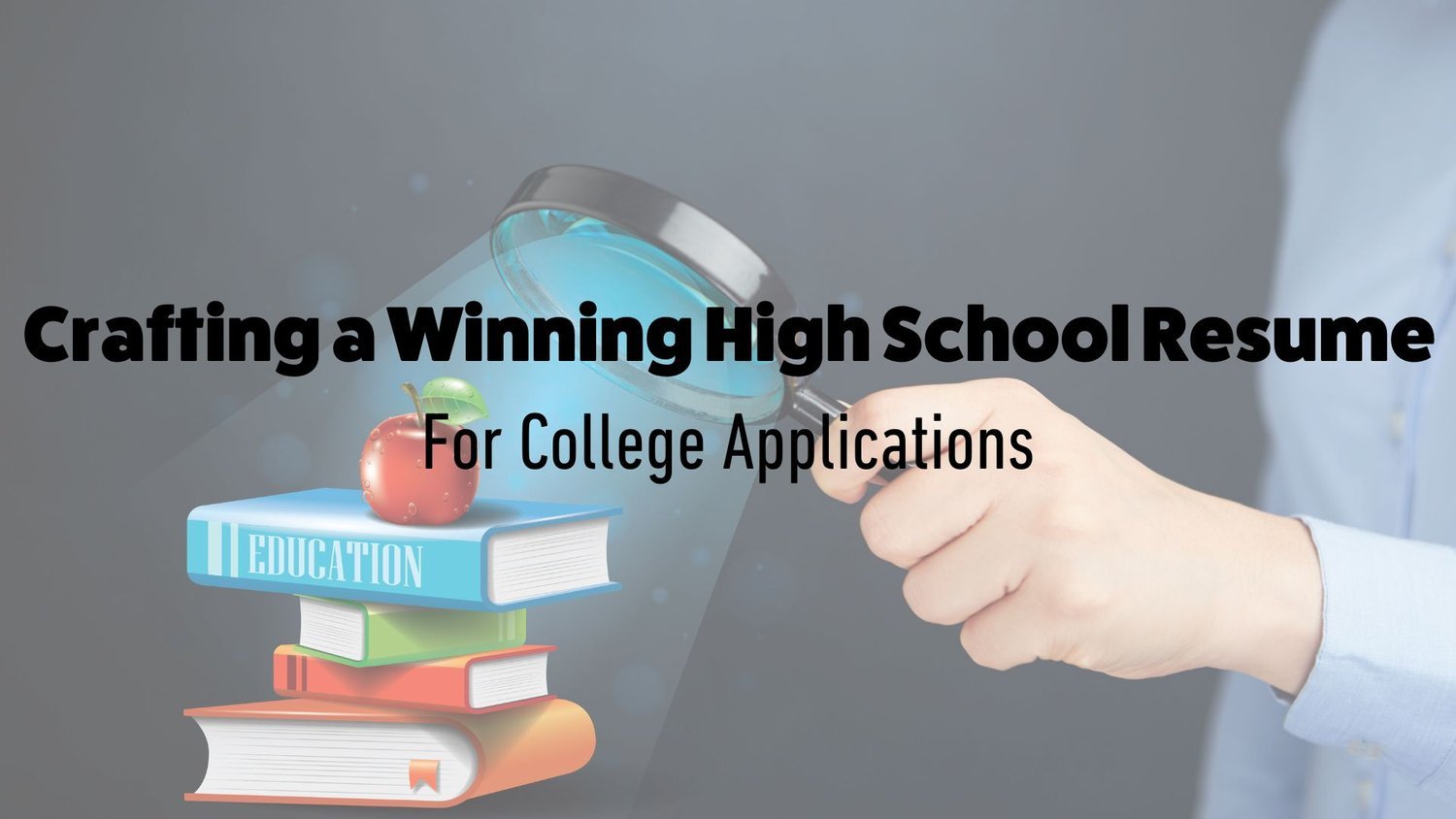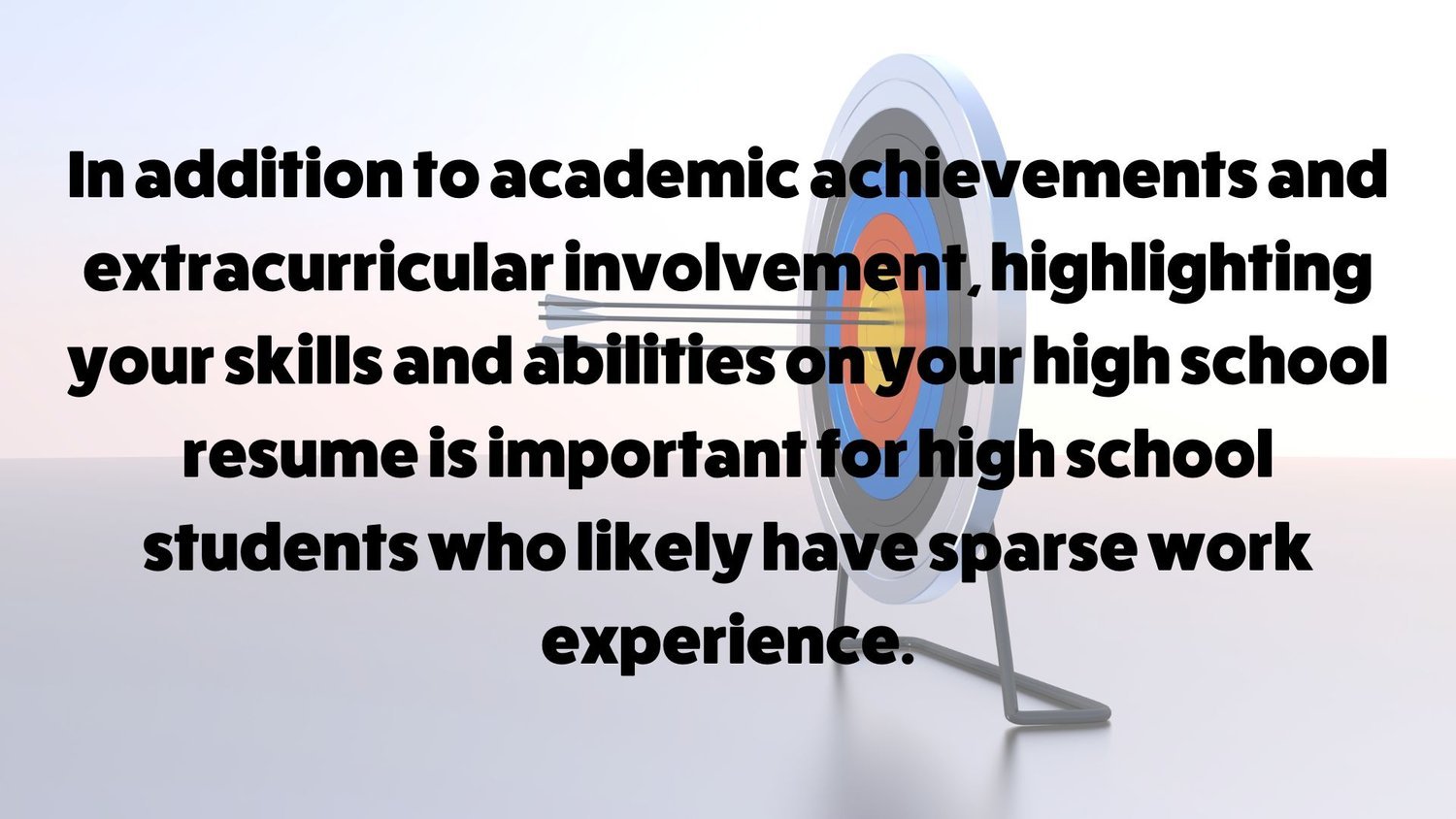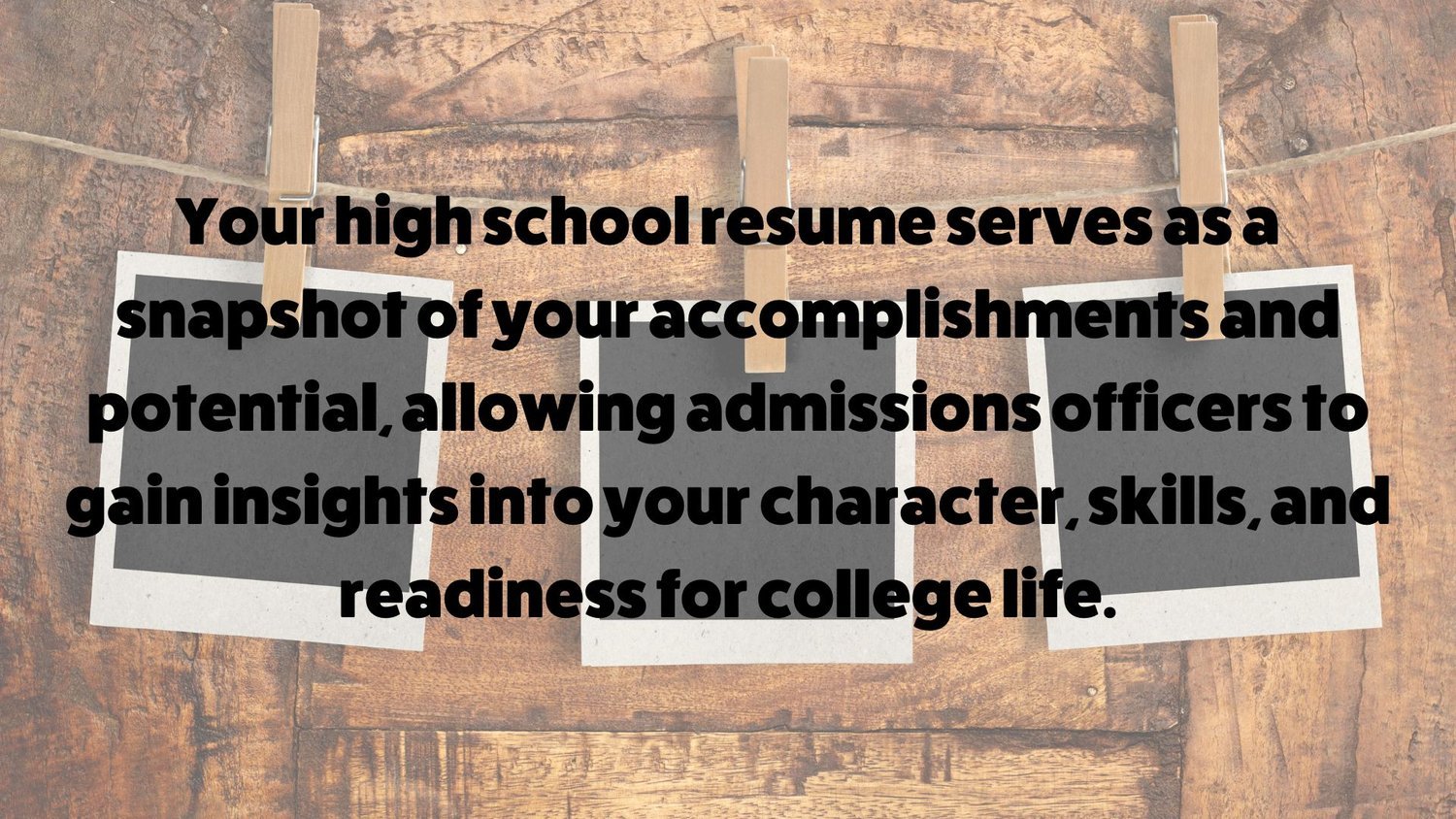Crafting a Winning High School Resume for College Admissions
When it comes to college applications, a well-crafted high school resume can make a significant difference. It serves as a powerful tool to present a comprehensive overview of your academic achievements, extracurricular involvement, and personal growth throughout your high school years. College admissions officers review numerous applications, and a well-structured and thoughtfully designed resume can set you apart from the competition.
Your high school resume is an opportunity to showcase your unique qualities, experiences, and potential as a prospective college student. It allows admissions officers to gain insights into your academic performance, leadership abilities, community involvement, and other accomplishments beyond just grades and test scores. By strategically organizing and highlighting your achievements, you can paint a compelling picture of your abilities and demonstrate your readiness for college life.
Interested in showcasing your intellectual vitality and initiative on college applications? Find out how YOU can apply artificial intelligence to the subjects that interest you in InspiritAI’s AI Scholars Program. Students in the Inspirit AI Scholars program craft interdisciplinary AI projects engaging subjects of personal interest to them. Additionally, many students who have participated in the AI+X Individual Research Mentorship have gone on to win prestigious awards at various science fair competitions!
In this blog post, we will explore essential tips and strategies for creating a winning high school resume that will impress college admissions officers. By following these guidelines, you can effectively showcase your skills, experiences, and potential, increasing your chances of getting accepted into your dream college. So, let's dive in and learn how to craft a high school resume that will make a lasting impression!
UNDERSTANDING THE PURPOSE OF A HIGH SCHOOL RESUME
Before delving into the specifics of crafting an outstanding high school resume, it's crucial to understand its purpose. A high school resume is not just a mere summary of your academic history; it is a powerful tool that can help you make a compelling case for your admission to colleges.
The primary goal of a high school resume is to provide college admissions officers with a concise yet comprehensive snapshot of your accomplishments, experiences, and potential. While your transcript provides information about your grades and courses, the resume allows you to go beyond those numbers and showcase the qualities that make you a well-rounded candidate.
By crafting a well-structured and compelling high school resume, you have the opportunity to highlight your academic achievements, extracurricular involvement, leadership roles, community service, work experience, and any other notable accomplishments. It serves as a platform to demonstrate your commitment, passion, and growth throughout your high school years.
Admissions officers review countless applications, and a well-crafted high school resume can help you stand out from the competition. It allows them to form a holistic understanding of who you are as an individual and what you can contribute to their college community. It helps them gauge your potential for success in academics, leadership, and overall engagement on campus.
In summary, a high school resume is your chance to tell a story about yourself, presenting a multidimensional portrait of your capabilities and aspirations. It is an integral part of your college application that enables you to leave a lasting impression on admissions officers.
FORMATTING AND STRUCTURE
To create an organized and visually appealing high school resume, it's important to pay attention to the formatting and structure. A well-structured resume not only enhances readability but also demonstrates your attention to detail and professionalism.
1. Choose a clear and professional font
Select a font that is easy to read, such as Arial, Calibri, or Times New Roman. Stick to a consistent font throughout your resume to maintain a cohesive look.
2. Use consistent formatting
Maintain consistency in formatting for headings, bullet points, and spacing. This creates a visually pleasing and easy-to-follow resume. Align your text to the left for a clean and professional appearance.
3. Start with your contact information
Place your name, phone number, email address, and home address (optional) at the top of the resume. Make sure your contact details are current and professional.
4. Include relevant sections
Organize your high school resume into sections such as Education, Extracurricular Activities, Work Experience, Volunteer Experience, Awards and Honors, and Skills. This division helps admissions officers quickly find the information they need.
5. Arrange sections in reverse chronological order
Within each section, list your experiences in reverse chronological order, starting with the most recent ones. This allows admissions officers to see your most recent accomplishments first.
6. Tailor the length of your resume
Ideally, a high school resume should be one or two pages long. If you have extensive experiences and achievements, prioritize the most relevant ones and be mindful of brevity. Keep in mind that admissions officers review numerous applications, so a concise resume that highlights your key strengths is preferable.
Remember, simplicity and clarity are key when it comes to formatting your high school resume. A clean and well-structured resume will make it easier for admissions officers to navigate and find the information they seek, leaving a positive impression of your organizational skills and attention to detail.
SHOWCASING ACADEMIC ACHIEVEMENTS
Your academic achievements play a crucial role in your high school resume. They provide insights into your intellectual capabilities, work ethic, and commitment to learning. Here are some tips for effectively highlighting your academic achievements:
1. Include your GPA, class rank, and standardized test scores
These are important indicators of your academic performance. Include your GPA on a 4.0 scale, class rank, and any notable test scores such as SAT or ACT. If you have taken advanced or honors courses, mention them as well.
Example:
GPA: 3.8/4.0, Class Rank: Top 10%
SAT: 1450 (Math: 750, Reading and Writing: 700)
2. Highlight academic projects or research
If you have participated in any noteworthy academic projects or conducted research, mention them. Describe the scope of the project, your role, and any significant findings or outcomes.
Example:
Conducted independent research on the impact of climate change on local ecosystems, presenting findings at a regional science fair.
3. Showcase academic awards or recognition
Include any academic awards, scholarships, or honors you have received. This could be a subject-specific award, academic competition recognition, or membership in an honors society.
Example:
National Merit Scholar Semi-Finalist
Recipient of the Mathematics Excellence Award
4. Mention relevant coursework
If you have taken courses that are particularly relevant to your intended field of study or demonstrate academic rigor, mention them. This can include advanced placement (AP) courses, International Baccalaureate (IB) courses, or dual enrollment courses.
Example:
AP Calculus BC
IB Biology HL
5. Connect academic achievements to personal growth
When describing your academic achievements, consider reflecting on how they have contributed to your personal growth, passion for learning, or future goals. This provides context and helps admissions officers understand the impact of your academic journey.
Example:
Pursuing a challenging course load fueled my curiosity for science and inspired me to pursue a degree in environmental studies.
Remember to focus on quality over quantity when showcasing academic achievements. Select the most relevant and impressive accomplishments that highlight your dedication to academics and your potential for success in college.
HIGHLIGHTING EXTRACURRICULAR INVOLVEMENT
Extracurricular activities demonstrate your ability to balance academics with other interests, showcase your leadership skills, and highlight your commitment to personal growth outside of the classroom. Here are some tips for effectively highlighting your extracurricular involvement on your high school resume:
1. List clubs, organizations, or teams
Include the extracurricular activities you have participated in during high school. This can range from academic clubs and honor societies to sports teams, cultural organizations, or community service groups.
Example:
Debate Club
National Honor Society
Varsity Soccer Team
2. Describe leadership roles and responsibilities
If you have held any leadership positions within your extracurricular activities, be sure to mention them. Describe your responsibilities, achievements, and any impact you made in your leadership role.
Example:
President, Key Club: Organized and led community service projects, increasing membership by 20% and raising $5,000 for local charities.
3. Highlight significant accomplishments or contributions
Emphasize any notable accomplishments or contributions you have made within your extracurricular involvement. This could include winning competitions, organizing events, or implementing initiatives that had a positive impact.
Example:
Coordinated a fundraising gala for the school theater department, raising $10,000 to support new production equipment.
4. Emphasize long-term commitments
Admissions officers appreciate seeing long-term dedication to an extracurricular activity. If you have been involved in a specific club, organization, or team for multiple years, highlight the duration of your commitment.
Example:
Member, Robotics Club (Sophomore to Senior Year)
Ambassador, Inspirit AI (Freshman to Senior Year)
5. Connect activities to personal growth and interests
When describing your extracurricular involvement, discuss how these activities have contributed to your personal growth, interests, or future goals. Explain how your participation has shaped your character, skills, or perspectives.
Example:
Volunteering at a local animal shelter sparked my passion for animal welfare and inspired me to pursue a career in veterinary medicine.
Remember to be selective and highlight the extracurricular activities that are most relevant to your interests, showcase your strengths, and align with your college and career aspirations. Admissions officers are interested in seeing depth and commitment rather than a long list of superficial involvements. Use action-oriented language and specific examples to demonstrate your active engagement and the impact you have made within each activity.
Additionally, consider the balance between academic and extracurricular involvement. If you have limited space on your resume, prioritize the activities that best complement your academic achievements and demonstrate a well-rounded profile.
DEMONSTRATING COMMUNITY SERVICE AND VOLUNTEER WORK
Community service and volunteer work are valuable experiences that showcase your dedication to making a positive impact in your community. Admissions officers value applicants who actively contribute to society and demonstrate a commitment to helping others. Here are some tips for effectively highlighting your community service and volunteer work on your high school resume:
1. List the organizations and causes you have been involved with
Include the names of the community service organizations or volunteer groups you have worked with. This can range from local nonprofits to school-based initiatives or international service trips.
Example:
Habitat for Humanity
Red Cross Club
Local Food Bank
2. Describe your responsibilities and accomplishments
Detail your specific role and responsibilities within each community service or volunteer opportunity. Highlight any accomplishments or achievements that demonstrate the impact you made.
Example:
Tutored elementary school students in math and helped improve their grades by 20%.
Organized a fundraising campaign for a homeless shelter, raising $5,000 to provide food and clothing for those in need.
3. Quantify your impact
Whenever possible, provide quantitative data or statistics to illustrate the scale of your contributions. This helps admissions officers understand the magnitude of your efforts and the difference you have made.
Example:
Coordinated a team of 20 volunteers to serve meals at a local soup kitchen, feeding over 500 individuals in need.
4. Emphasize long-term commitments or sustained involvement
If you have dedicated a significant amount of time to a particular community service or volunteer initiative, emphasize the duration of your commitment. Long-term involvement demonstrates your consistency and dedication to a cause.
Example:
Volunteer, Animal Shelter (10 hours per week, Junior and Senior Year)
5. Reflect on the impact and personal growth
Briefly reflect on how your community service and volunteer experiences have impacted your personal growth, values, and future aspirations. Discuss any valuable lessons or insights you have gained from these experiences.
Example:
Working with elderly residents at a local nursing home taught me the importance of empathy and sparked my interest in pursuing a career in healthcare.
Community service and volunteer work should be approached with genuine passion and a desire to make a positive difference. Admissions officers are interested in understanding how your experiences have shaped your character, values, and sense of social responsibility. Use descriptive language and specific examples to showcase the depth of your involvement and the impact you have had on the communities you served.
SHOWCASING WORK EXPERIENCE AND INTERNSHIPS
Work experience and internships can provide valuable insights into your professional development, responsibility, and transferable skills. They demonstrate your ability to navigate real-world environments and contribute to the workforce. Here are some tips for effectively showcasing your work experience and internships on your high school resume:
1. List the companies or organizations you have worked for
Include the names of the companies or organizations where you have gained work experience or completed internships. This can be part-time jobs, summer employment, or internships in your field of interest.
Example:
ABC Company, Sales Associate
XYZ Hospital, Volunteer Intern
2. Describe your job responsibilities and achievements
Detail the specific tasks, duties, and responsibilities you had in each work experience or internship. Highlight any notable achievements or accomplishments that showcase your skills, growth, or contributions.
Example:
Managed inventory, assisted customers with product selection, and achieved a 15% increase in sales during peak periods.
Conducted research and data analysis for a research project, contributing to the development of a new treatment protocol.
3. Highlight transferable skills
Emphasize the transferable skills you have gained through your work experience or internships. These can include communication skills, teamwork, problem-solving, customer service, or time management.
Example:
Developed strong interpersonal skills by interacting with diverse customers and resolving their inquiries effectively.
Demonstrated adaptability and problem-solving abilities by handling unexpected challenges during a fast-paced internship.
4. Connect work experience to your future goals
When describing your work experience and internships, make connections to your future academic or career goals. Explain how these experiences have influenced your aspirations and provided valuable insights into your chosen field.
Example:
Working as a research assistant in a biology lab solidified my passion for scientific research and inspired me to pursue a degree in biomedical engineering.
5. Include relevant certifications or training
If you have obtained any certifications or completed relevant training programs during your work experience or internships, mention them. This demonstrates your commitment to professional growth and acquisition of specialized skills.
Example:
Certified in CPR and First Aid through training provided during internship at a local hospital.
Remember to showcase the quality and significance of your work experience and internships rather than the quantity. Select the most relevant and impactful experiences that align with your academic and career goals. Focus on the skills you have gained, the responsibilities you have handled, and the accomplishments you have achieved. This will demonstrate your readiness for the professional world and your ability to thrive in future academic and career endeavors.
SHOWCASING AWARDS AND HONORS
Awards and honors are tangible recognitions of your outstanding achievements and exceptional abilities. They provide evidence of your excellence in specific areas and serve as a testament to your dedication and hard work. Here are some tips for effectively showcasing your awards and honors on your high school resume:
1. Include academic, extracurricular, and community-based awards
List the awards and honors you have received throughout your high school years. This can encompass academic achievements, leadership awards, athletic recognitions, artistic accomplishments, community service honors, or any other notable distinctions.
Example:
National Merit Scholarship Finalist
All-State Orchestra Selection
Outstanding Volunteer Award, Local Community Center
2. Provide context for each award
Briefly explain the significance and selection criteria of each award. This helps admissions officers understand the scope and prestige of the recognition you have received.
3. Highlight the impact or accomplishments behind the awards
Describe the specific accomplishments, projects, or activities that led to the receipt of each award. Explain how your efforts or achievements have made a difference or set you apart from your peers.
Example:
Outstanding Volunteer Award, Local Community Center: Recognized for organizing and leading a successful fundraising event that raised over $10,000 for community development programs.
4. Quantify the impact of your achievements
Whenever possible, provide quantitative data or statistics to demonstrate the extent of your achievements. This adds credibility and helps admissions officers understand the scale and magnitude of your accomplishments.
Example:
State Debate Champion: Won first place in a state-level debate competition, competing against 50 schools and delivering persuasive arguments with a success rate of 90%.
5. Arrange awards in order of significance
Prioritize the awards and honors based on their significance and relevance to your college application. Place the most prestigious and relevant recognitions at the top of the list to immediately capture the attention of admissions officers.
Try to strike a balance between showcasing your accomplishments and overwhelming the reader with an extensive list. Focus on the most significant and impactful awards that highlight your exceptional abilities, dedication, and contributions. By effectively showcasing your awards and honors, you will provide admissions officers with a clear understanding of your outstanding achievements and the recognition you have received for your efforts.
DEMONSTRATING SKILLS AND ABILITIES
In addition to academic achievements and extracurricular involvement, highlighting your skills and abilities on your high school resume is important for high school students who likely have sparse work experience. Skills and abilities demonstrate your capacity to excel in various areas and indicate your preparedness for college-level academics and future professional endeavors. Here are some tips for effectively demonstrating your skills and abilities:
1. Identify relevant skills
Identify the skills that are most relevant to your desired field of study or future career. These can include technical skills (such as programming languages or software proficiency), communication skills, leadership skills, problem-solving abilities, or critical thinking skills.
Example:
Technical Skills: Java programming, Adobe Photoshop, Microsoft Office Suite
Communication Skills: Effective public speaking, written communication, and interpersonal skills
2. Incorporate skills into descriptions
Integrate your skills and abilities into the descriptions of your experiences, such as academic projects, extracurricular activities, volunteer work, or work experience. Describe how you have utilized and developed these skills in various contexts.
Example:
Applied critical thinking skills to analyze complex data sets and present findings in a clear and concise manner for a science research project.
3. Provide evidence or examples
Whenever possible, provide specific examples or evidence that demonstrate your skills in action. This can include accomplishments, projects, or tasks where you successfully utilized your skills to achieve positive outcomes.
Example:
Developed a mobile application as part of a coding club project, showcasing proficiency in Java programming and user interface design.
4. Showcase transferable skills
Highlight transferable skills that are applicable across different domains or industries. These skills, such as teamwork, adaptability, time management, or problem-solving, are valued in various academic and professional settings.
Example:
Demonstrated strong leadership and teamwork skills through successful coordination of a group project in a school club.
5. Tailor skills to the college application
When selecting which skills to emphasize, consider the specific requirements or expectations of the colleges or programs you are applying to. Highlight the skills that align with their values and showcase your readiness for success in their academic environment.
Provide a balance between breadth and depth when showcasing your skills and abilities. Select a few key skills that are most relevant and significant to your academic pursuits and future aspirations. By effectively demonstrating your skills and abilities, you will provide admissions officers with a comprehensive understanding of your strengths and potential contributions as a college student.
TAILORING YOUR RESUME TO EACH COLLEGE
While it's important to have a strong foundation for your high school resume, customizing it for each college you apply to can make a significant impact. Tailoring your resume shows your genuine interest in the specific college and helps highlight the experiences and achievements most relevant to their unique programs and values. Here are some tips for tailoring your resume:
1. Research the college
Gain a thorough understanding of the college's mission, academic programs, and values. This will help you identify the key qualities and experiences they prioritize in their admissions process.
2. Prioritize relevant experiences
Evaluate your experiences, accomplishments, and skills in light of the college's expectations. Highlight those that directly align with their specific academic programs, extracurricular activities, or campus culture.
3. Customize sections and order
Rearrange or emphasize sections based on what the college values most. For example, if the college has a strong emphasis on community service, emphasize your relevant volunteer work by placing it prominently on your resume.
4. Include college-specific achievements
If you have received any honors, awards, or recognitions from the college or participated in college-specific programs or competitions, be sure to include them to showcase your connection and involvement with the institution.
5. Tailor your objective statement
If you include an objective statement at the beginning of your resume, customize it to reflect your specific interest in the college and how your experiences align with their academic or career goals.
Customization should be genuine and reflective of your actual experiences. Avoid embellishing or misrepresenting your achievements. By tailoring your resume, you demonstrate your enthusiasm for the college and present a compelling case for why you are a strong fit for their institution.
Conclusion
Crafting a winning high school resume for college applications is a crucial step in showcasing your achievements, experiences, and unique qualities to admissions officers. By following the tips and strategies provided in this blog post, you can create a compelling resume that stands out from the competition. Remember to consider the purpose of the resume, pay attention to formatting and structure, and effectively showcase your academic achievements, extracurricular involvement, community service, work experience, awards and honors, skills and abilities, and tailor it to each college you apply to.
Your high school resume serves as a snapshot of your accomplishments and potential, allowing admissions officers to gain insights into your character, skills, and readiness for college life. It's important to present a well-organized and impactful document that highlights your strengths, passions, and commitment.
As you work on your high school resume, keep in mind that quality is more important than quantity. Select the most relevant and meaningful experiences and focus on demonstrating your impact and growth. Use specific examples, quantifiable achievements, and reflective statements to provide a comprehensive picture of who you are as a student and individual.
Lastly, always proofread your resume carefully, ensuring it is error-free, concise, and visually appealing. Seek feedback from teachers, mentors, or counselors to make further improvements. Your high school resume is a powerful tool that can help open doors to the college of your dreams. With careful attention to detail and thoughtful presentation, you can create a resume that truly showcases your potential and maximizes your chances of admission to your desired colleges. Good luck!
About Inspirit AI
AI Scholars Live Online is a 10 session (25-hour) program that exposes high school students to fundamental AI concepts and guides them to build a socially impactful project. Taught by our team of graduate students from Stanford, MIT, and more, students receive a personalized learning experience in small groups with a student-teacher ratio of 5:1.




